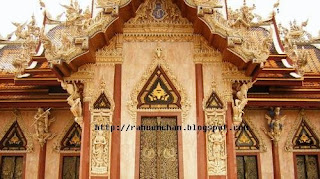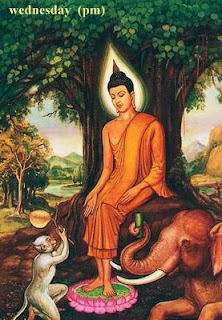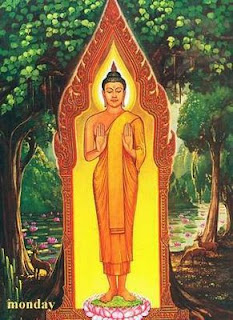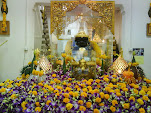Friday, 31 July 2009
Wednesday, 29 July 2009
Sunday, 26 July 2009
Doing Merit on Birthday.
When i got there, i went straight to the monk and place the bucket(1) near his seat and proceed to the backyard for a pial of water. I passed the flowers to him and he start cutting the lime and coconust husk, light the candle and go round the pail with a white string. Then he handed the string to me and start chanting. Wow, the chanting, not what a thought a short one, my leg was cramped and in fact i started to shiver. Then after about 25-30min of chant, i was told to proceed for my shower.
After finishing the shower, i thought i can proceed to pay my respect to all the Buddha, i was called by the monk to sit down and he ask me to repeat after him another chant... That lasted about 10min and lastly he gave me a cup of holy water (during the chanting, i'm supposed to pour the holy water into a small cup as the monk do his chant) Then he ask me to go out and pour away the water(2).
The whole process then completed. It's so refreshing and the feeling was peaceful and calm.
**Note- (1) Buckets are offered to Monks as a way to gain Merit. The items incuded are rice, candles, tooth brush, tooth paste, medication, joss stick, monk robe, soap, toilet roll, drinking water and many more.
(2) Pouring holy water on the floor is called- SAT NAM. This is to give strength and good deeds to the spirit. It give good deeds to the dead and help them to shorten the time to wait for next life.
Friday, 24 July 2009
Wednesday, 22 July 2009
Tuesday, 21 July 2009
Monday, 20 July 2009
Sunday, 19 July 2009
Saturday, 18 July 2009
泰国佛牌
其实我觉得佛牌之神奇作用来源,可以说主要来自经文力量,佛牌必定要经过高僧开光诵经加持后,才会有神奇作用,但佛牌的神奇作用,只是一种助力,像人缘、财运、事业这些功效,不是佩带了佛牌并能横财就手、事业平步青云,因凡事必需要经过自身努力才能得到成果。
Meaningful Quotes ~ Ajarn Fuang
Friday, 17 July 2009
Thursday, 16 July 2009
Meaningful Quotes from Ajarn Chah
"People who suffer will accordingly gain wisdom. If we don't suffer, we don't contemplate. If we don't contemplate, no wisdom is born. Without wisdom, we don't know. Not knowing, we can't get free of suffering -- that's just the way it is. Therefore, we must train and endure in our practice. When we then reflect on the world, we won't be afraid like before. It isn't that the Buddha was enlightened outside of the world, but within the world itself."
"Remember you don't meditate to 'get anything', but to get 'rid' of things. We do it, not with desire, but with letting go. If you 'want' anything, you won't find it."
"Everything is uncertain. Don't cling to anything."
3圈转大运 拉胡驱恶
拉胡最恨小人
绕了三圈回家后,运程得好转者,往往再携带亲朋友戚友再回来感谢神恩,导致此尊在泰国南传佛教中盛行的拉胡天神,一夜之间,香火旺盛。
「转运12生肖拉胡天神乍督康」,全身黑色,只有半身,而容凶恶,不了解的善男信女,初见拉胡天神的长相,会被其外形吓到,但是了解拉胡天神的故事与来历,才知道,原来拉胡天神,是我们人的贵星吉星,我们的运程的起落,与它息息相关,我们人如果要过得一帆风顺,不要有小人阻碍,一定要拜「拉胡天神」,因为拉胡最忌小人,也是最讨厌小人。
拉胡天神,为何名叫「拉胡」?它的名字有这样的传说,这是因为当我们运程低时,这位天神就会「拉」及「扶」我们一把,所以大家尊称它为拉胡!
拉胡,是泰国民间流传已经久的天神,在泰国南传佛教的佛寺,有很多都会安座拉胡天神,以供各界膜拜。
口咬太阳月亮
大家都知道,拉胡天神最专长的神力,就是克制小人,凡运气受阻,小人陷害,诸事不顺者,如果膜拜拉胡天神,则将得到无比的神力加持庇佑。
每个人都会有运程起伏,好运时得贵人扶持,行衰运时就遇小人,小人作恶多端。
泰国人克制小人的方法是膜拜拉胡,配戴拉胡,拉胡除了全身黑色,头戴花盖,身躯高大,口中咬着太阳月亮,神情十分凶恶,让人敬畏。
为何拉胡是半身呢?
故事原来是这样的,根据传说,拉胡生性顽皮,经常闯祸,令到众神仙非常讨厌他,而其中最讨厌他的是月亮,有一天,月亮和太阳向众神之神舌娃告拉胡,指拉胡是一名邪神,经常做坏事,舌娃得知后大怒,便将拉胡横腰斩断。
最后,舌娃查明真相,才发现原来拉胡是一名正神,于是就封他为「正神拉胡」,以沉冤得雪,并列为仙班。
得雪沉冤升仙班
也因为如此,拉胡被月亮女神陷害后,非常憎恨喜欢背后中伤他人的小人,所以拉胡天神又有一个名字,则是「食小人佛」尊称。
鉴于拉胡的半身被斩去,全因是月亮女神背后中伤他而导致,所以拉胡嫉恶如仇,在其金身,张开大口,口咬住月亮,便是这个缘故。
而在华人俗称,为天狗抱月,是民间流传己久的灵物,凡供奉或配戴者,都知道,拉胡佛牌是泰国人把日蚀和月蚀,当作是「拉胡天神」对「日月两神」的处罚,每逢日蚀和月蚀,泰国人认为,这是向拉胡请求庇佑和许愿的最好时机。
膜拜拉胡的供品,则必须黑色,如黑腊烛,黑香,黑咖啡。只要诚心向拉胡天神祈求,拉胡会将一切不好的东西带走,而回报一切好的东西给诚心者。
配戴拉胡者,遇上运气低时,拉胡就如护法神护持着,让配戴者顺利平安,小人远离,事事顺利。
Wednesday, 15 July 2009
Merit during Birthday
An old Thai proverb says it best: “if you do good you will receive good; if you do evil you will receive evil ”.
The Thai Buddhist tradition is to contemplate your birth and consider too that sometime your life will end as part of the circle of life, death and rebirth. It’s also the day to pay respect to your mother for the endurance in carrying and giving birth to you and bringing you up.
Many Thais rather spend their birthday giving, or making merit, than receiving gifts. The typical merit for your birthday in Thailand is to donate a coffin to be used by a poor family to part from their beloved. The idea behind it is that giving without expecting returns will benefit your karma and thus promote your own luck.
I was mentioning that I wanted to get the Alm Bucket~ small beach buckets filled with rice, candles, incense, flashlight, and other things the monks need.) for the monk on my birthday and I am still thinking of many other ways which I can do it too, such as through prayer, donating of coffin, monk robe and perhap donating blood.
Tuesday, 14 July 2009
Tiger God in Thailand (虎爷)
 Another place where you can find the Tiger God is in the shrine next to Ruamkatanyu Foundation at Wat Hua Lampong. Not only you can pray to the tiger God, you can also come here for merit making by donating coffin for victims killed in accidents or murdered where nobody had come forward to claim or identify the body. I was there in March and we made donation of coffin too.
Another place where you can find the Tiger God is in the shrine next to Ruamkatanyu Foundation at Wat Hua Lampong. Not only you can pray to the tiger God, you can also come here for merit making by donating coffin for victims killed in accidents or murdered where nobody had come forward to claim or identify the body. I was there in March and we made donation of coffin too.
Monday, 13 July 2009
Poh Teck Tung Foundation 报德善堂
 The Poh Teck Tung is a voluntarely Organisation originated from China, situated in Bangkok since 1909, that has hundreds of volunteer workers to clean the streets of the dead.
The Poh Teck Tung is a voluntarely Organisation originated from China, situated in Bangkok since 1909, that has hundreds of volunteer workers to clean the streets of the dead.Sunday, 12 July 2009
Phra Si Mahathat Temple (Wat Phra Si Mahathat) (Phitsanulok)
Phra Phutthachinnarat is considered the most beautiful Buddha image in Thailand. The large Sukhothai-style bronze statue was cast in 1357 by the order of King Maha Thamma Racha I of Sukhothai. The statues unique feature is the flame-like halo a symbol of spiritual radiance. In 1931, King Ekatotsarot (King Naresuan’s younger brother) commanded a gold coating of the image, making it outstanding against the dark backdrop.On either side of Phra Phuttha Chinarat are numerous smaller Buddha images.
Getting there
Phitsanulok is fifty kilometers (31 miles) east of Sukhothai.
Saturday, 11 July 2009
LP Koon Statue
 Bronze statue of Luang Pu Koon. Very nice, belonging to an uncle who rent it @ Wat Ban Rai 10 years ago.
Bronze statue of Luang Pu Koon. Very nice, belonging to an uncle who rent it @ Wat Ban Rai 10 years ago. Friday, 10 July 2009
Luang Pu Koon Yant
 This yant was in my drawer for sometime and it's only recently when i start to do some cleaning upi then i found it. According to the thai word on the yant, it's for improving of wealth and business prosperity. So out of curiousity, i check the website and realised people are selling it at S$40/- ! Wow.. and to think i got it free! Anyway, I have given it to a colleague, for a price of $2/-( he say cannot take for free) and i used it for donation to a temple.
This yant was in my drawer for sometime and it's only recently when i start to do some cleaning upi then i found it. According to the thai word on the yant, it's for improving of wealth and business prosperity. So out of curiousity, i check the website and realised people are selling it at S$40/- ! Wow.. and to think i got it free! Anyway, I have given it to a colleague, for a price of $2/-( he say cannot take for free) and i used it for donation to a temple.He was a devotee of Lp Koon because according to him, during the darkest period of his life, he dreamt of LP Koon and from there, he became a follower. He was very happy that he got the yant and me too, it's always great to make someone happy!
The 10th Lunar Month for making Merit @ Thailand
The 10th Lunar Month Making Merit
5 Sep 2009 - 19 Sep 2009
Venue : Wat Phra Mahathat Woramahawihan and Suan Somdej Phra Sinagarindra 84
(Thung Tha Lat Park), Amphoe Mueang, Nakhon Si Thammarat
Features a large and splendorous event of Nakhon Si Thammarat, experience the spectacular procession from Sanam Na Mueang to Wat Phra Mahathat Woramahawihan. Purchase various local products on sale and enjoy various forms of entertainment.
Bathing Buddha Ceremony
17 Sep 2009 - 21 Sep 2009
Venue : Phetchabun City Hall, in front of Traipoom Temple and Botchanamarn Temple
A Bathing Buddha, or Um Phra Dam Nam ceremony, is held during September each year. It is a traditional religious and well known ritual held annually in Phetchabun.
Buddha statue, called Phra Buddha Mahadhamaracha cast in the ornamental Lop Buri style, was found in the Pasak River by a group of farmers four hundred years ago and it was then taken to be housed in Wat Trai Phum. According to a legend, the Buddha statue was disappeared twice from the temple and was later found in water.
The ceremony starts at 1 p.m. The Buddha statue is carried around town and put under a tent in Wat Trai Phum, so buddhists can pay respect to the image and stick gold leaf on the body of the Buddha statue. In the evening, prayers are chanted. At night, there are various kinds of entertainment. The next morning, people make merit as it is Sat Thai Day. Foods, including Krayasat and other necessities are given to monks. The Buddha statue is then taken to be immersed in the Pasak River by the local governor of Phetchabun in the belief that this act brings happiness and fertility to the province and traditional dances are performed to show respect to the Buddha statue.
After the ceremony, the water in the river is regarded as sacred. As a result, people swim in it or take the water to drink before the boat racing begins.
Phuket Vegetarian Festival 2009
18 Oct 2009 - 26 Oct 2009
The Thai-Chinese in Phuket have long passed on the vegetarian festival to purify mind and soul by refraining from meat consumption and meditating. Symbolising the presence of the deities throughout the festival are 9 lanterns lit up and placed aloft on Ko Teng poles. On the 6th day of the festival, there will be religious processions and incredible displays of face-and-body piercing. On the last day, there will be a “Koi Han” ceremony to exorcize ill fortune and a farewell ceremony for the deities at night.
Wednesday, 8 July 2009
My New Altar
 As you can see, I have actually replace some of the statue with 2 statues of Monks ( Luang Pu Tuad & Archan Toh) and suddenly the altar seems so empty. Initially we wanted to return the statues to the temple which we got them from, but a friend, who was the committee member of the temple said he likes Guanyin statue and another of his friend wanted the Rahu & Sangkaja. We have made it clear to him that we gave him becos he wanted them and There is no money involve as that was a promise we had with all the statues before we gave them away, should someone breaks this promise by making money through selling away the statues, he would have to answer the consequences.
As you can see, I have actually replace some of the statue with 2 statues of Monks ( Luang Pu Tuad & Archan Toh) and suddenly the altar seems so empty. Initially we wanted to return the statues to the temple which we got them from, but a friend, who was the committee member of the temple said he likes Guanyin statue and another of his friend wanted the Rahu & Sangkaja. We have made it clear to him that we gave him becos he wanted them and There is no money involve as that was a promise we had with all the statues before we gave them away, should someone breaks this promise by making money through selling away the statues, he would have to answer the consequences.The small Buddha statue was given to my colleague and I know the statue will be in good hand.
Making Merit
Thais make merit more generally by every wholesome action they undertake each day, a very good example, by giving food to monks every morning.
What does the book Buddhism Explained say about Giving?
Why is giving so important? If we are to make any progress along the Buddha’s way, we shall have to reverse our normal worldly ways. Worldliness talks about getting, and the Way talks about giving. So, the objective of giving is to break down, or at least to make a start on the destruction of the prison walls of ‘I have’. Now, giving should be done from the heart, proceeding from a pure faith which holds that the act of giving is meritorious, that the person to whom the giving is directed (often Buddhist monks and nuns) are pure and strive to lead a good life, and that the effect upon the giver is to ensure a happy rebirth, if nothing more. In the practice of giving one should never expect any return, the only return being that one’s own heart then becomes flexible and one’s ways easier to train.
Merit, as explained above, cannot really belong to one. Merit is actually made by giving away one’s merit. This is a way of teaching that one should not even be attached to the results of wholesome conduct but using wholesome conduct, one should push on to Nirvana, beyond both merit and demerit.So, when a Thai person is having a difficult time, they often resort to making merit in an effort to improve their kamma. They will often describe it in English as trying to change bad luck.
But Thais don’t only tamboon (make merit) when they are having bad luck. Ask a Thai person what he did on his birthday, he is more likely to say that he went to the wat (temple) to make merit.
On the anniversary of the death of a relative or close friend most Thais will go to the wat to make merit on that person’s behalf.I have decided that I shall go to Golden Mile to get the set of offering, usually a yellow pail with lots of daily nesscessity for Monks on my Birthday.
Monday, 6 July 2009
Quotes from Buddhism
The Buddha stresses that to escape from suffering one must not look to others for help, but do it himself.
"Your worst enemy cannot harm you as much
as your own unguarded thoughts."
Develop the mind of equilibrium.
You will always be getting praise and blame,
but do not let either affect the poise of the mind:
follow the calmness, the absence of pride.
-Sutta Nipata
Confused by thoughts,
we experience duality in life.
Unencumbered by ideas,
the enlightened see the one Reality."
- Hui - Neng
Wat Don Chan_ Chiangmai
Chiang Mai project gives poor children a shot at education
A hilltribe girl has the chance to study in the same way as other Thai students, even though her family does not have enough money to support her.
Published on September 10, 2007
Chiang Mai Polytechnic College director's special project and Don Chan Temple's abbot provide help for disadvantaged, orphaned and poor children.
Chanokporn Lekpaijit, 16, is one of 511 hilltribe students studying at Wat Don Chan School in Chiang Mai's Muang district. She is studying for a vocational certificate in accounting.
"I dream of being an accountant after graduation," she said, adding she would study for a higher degree at the same time if she could.
It may not sound as grand as some people's dreams, but to have a good job and earn money for herself and her family is a very great thing for this hilltribe girl.
"My family is poor, but I'm very glad that I have a school where I can study. Studying here, my mother's financial burden has decreased," the Hmong girl said with smile.
There are about 560 students in the school, studying from Prathom 1 to Mathayom 6 and aiming for vocational and higher vocational certificates.
College director Chamnan Thammachai said he had started the project for disadvantaged students in May.
"I wanted these students to have vocational knowledge so that they would have the chance to get a good job, leading them to a better quality of life," he added.
The project offers training in two fields - accounting and computers.
In addition, the director has assigned some teachers in conjunction with private companies to train students in cooking, baking, computer repairs and playing musical instruments.
Meanwhile, Phra Athikan Anan Anantoe, the abbot of the temple, has supported hilltribe students around the northern region for at least 23 years, including Hmong, Akha, Karen, Yao, Tai Yai (Shan) and Lisu.
He said he wanted to do something good for the
country and His Majesty
the King. Since the children placed a burden on the country, he had decided to help them.
"Only Thai people's kindness supports these children's expenses. The temple doesn't ask for financial support from any organisation. It's up to organisations and individuals who desire to help," Phra Athikan Anan said.
He has taught the children to follow the King's sufficiency philosophy, instructing them to eat together as well as to learn and live happily in simple conditions.
"The food for the students under the temple's patronage is donated by local people, including vegetables, fruits, seasonings and rice," Phra Athikan Anan said.
The children still need consumer products for daily use, especially washing powder and toothpaste. To offer these or other donations, call 05-324 0184.
Wannapa Phetdee
The Nation
Saturday, 4 July 2009
Buddha's Teaching
Friday, 3 July 2009
http://image.bbs.tom.com/data1/pic/766/7/7240_n.jpg
Thursday, 2 July 2009
Buddhism Ritual
Following of the rituals moves a person forward, on the path to enlightenment. The prayers are initiated with the evoking of a sangha. After the Sangha has been evoked, sadhaka or dharma student performs three prostrations, also known as three gates or three aggregates.
They consist of the body, the speech and the mind. They also indicate that the student has acknowledged the three bodies of Buddha, namely the Dharmakaya, the Smbhogakaya and the Nirmanakaya.
In the prostrations, five parts of the body touch the ground. These five body parts include the two palms, the two knees and the forehead, signifying the five elements of earth, water, fire, air and space. The other interpretations of the protestations symbolize the five wisdoms emanating from the five Buddha families and the five Buddha energies.
As a student performs these protestations, he surrenders himself to the Buddhas of past, present, and future and ten directions. The folded hands also connote a deeper meaning as a part of the Buddhist rituals. The touching of the ten fingers with each other symbolizes the ten directions. The right hand represents the male, active, yang energy, while the left hand represents the female, receptive, yin energy. When both of them join, they epitomize the Buddha's enlightening activity of upayakaushalya.
A number of other rituals also, follow these offerings to the deities and the three Jewels. These rituals include Bodhisattva vows, the 100-syllable Vajrasattva mantra, mandala offerings and the seven-line prayer of Guru Rinpoche and mon-lam prayers. After these rituals have been performed, the student practices meditation on shunyata or emptiness. The prayers come to an end with a ritual in which people express joy over the good deed and merit of others. They also request Buddha to teach them and not enter in parinirvana.


















